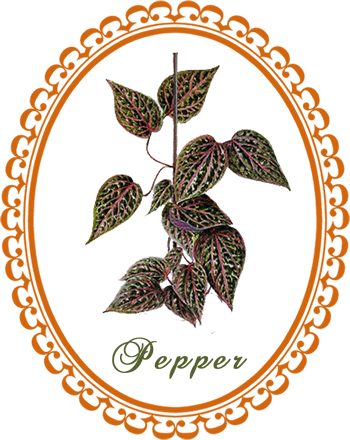
Pepper: one of the world's oldest traded spices, black pepper has a sharp, invigorating taste and a scent that promotes mental clarity ...
Common Names: Pepper
Botanical Name: Piper nigrum
Family: Piperaceae
Plant Type: Flowering vine
Parts Used: Dried peppercorns
Black pepper is native to India and is extensively cultivated there and elsewhere in tropical regions.
Description: The pepper plant is a perennial woody vine growing to four metres in height on supporting trees, poles, or trellises. It is a spreading vine, rooting readily where trailing stems touch the ground. The leaves are alternate, entire, five to ten centimetres long and three to six centimetres broad. The flowers are small, produced on pendulous spikes four to eight centimetres long at the leaf nodes, the spikes lengthening to seven to 15 centimeters as the fruit matures.
Cultivation: Pepper is a vining tropical plant that does well as a houseplant. It prefers bright, indirect light, such as that coming through sheer curtains, and warm temperatures. It will not fruit indoors.
Professional Cultivation: Black pepper is grown in soil that is neither too dry nor susceptible to flooding, moist, well-drained and rich in organic matter (the vines do not do too well over an altitude of 3000ft above sea level). The plants are propagated by cuttings about 40 to 50 centimetres long, tied up to neighboring trees or climbing frames at distances of about two metres apart; trees with rough bark are favoured over those with smooth bark, as the pepper plants climb rough bark more readily. Competing plants are cleared away, leaving only sufficient trees to provide shade and permit free ventilation. The roots are covered in leaf mulch and manure, and the shoots are trimmed twice a year. On dry soils the young plants require watering every other day during the dry season for the first three years. The plants bear fruit from the fourth or fifth year, and typically continue to bear fruit for seven years. The cuttings are usually cultivars, selected both for yield and quality of fruit. A single stem will bear 20 to 30 fruiting spikes.
Harvesting: The harvest begins as soon as one or two fruits at the base of the spikes begin to turn red, and before the fruit is mature, but when full grown and still hard; if allowed to ripen, the fruits lose pungency, and ultimately fall off and are lost. The spikes are collected and spread out to dry in the sun, then the peppercorns are stripped off the spikes.
Culinary Uses: Black pepper adds heat to any food, making it more digestible and - if used in moderation - more palatable. Pepper is a popular seasoning, second only to salt in its widespread use. Avoid the preground pepper and grind your peppercorns when you use them for added flavor. Black and white pepper are the two most common forms; they come from the same plant but are prepared differently. White pepper has its outer skin removed before drying; it has a milder flavor. There are also "gourmet" peppers available in an increasingly wider range of colors, each with a slightly different flavor. Use whole peppercorns in marinades; grind them for use in just about everything else.
Black Pepper Magick
Protection. Exorcism
Gender: Masculine
Planet: Mars
Element: Fire
Mix peppercorns with coarse sea salt and scatter around your property to dispel evil.
Add pepper to amulets to protect from the evil eye and free the mind of envious thoughts.
Herbal Healing with Black Pepper
Medicinal Actions: analgesic, antibacterial, antiseptic, detoxifier, diuretic, heating, stimulant (circulation; kidneys), tonifying (muscles)
Medicinal Uses: Black pepper is one of the more stimulating digestives, and has traditionally been used as a laxative for chronic constipation, although this has fallen out of use in contemporary herbalism in favor of more comfortable methods. The essential oil of black pepper warms and stimulates the body - it brings a flush of blood to the area where it is applied, which can be very useful to relieve the pain and inflammation of arthritis and rheumatism, muscular injuries, and joint strains and sprains. It enhances the effectiveness of other oils such as rosemary, cinnamon leaf and juniper berry.
Body Care with Black Pepper
- To energize stiff muscles, apply a black-pepper based massage oil to the affected areas using long, form strokes.
- To stimulate the body with a detoxifying body wash, make a black pepper soap and use it in your morning shower.
Energizing Massage Oil: Blend 4 drops black pepper, 3 drops rosemary and 3 drops lavender essential oils in 4 teaspoons sweet almond oil.
Stimulating Soap: Add 10 drops each black pepper and lavender essential oils to a bottle of 200 ml (6 1/2 fluid ounces) unscented liquid soap, stir with a wooden chopstick. Soap will last indefinitely.
Source: The Essential Herbs Handbook by Lesley Bremness
If you appreciate the information provided,
please help keep this website running. Blessings!
© 2008-2025 aromaworx.ca. All rights reserved.

